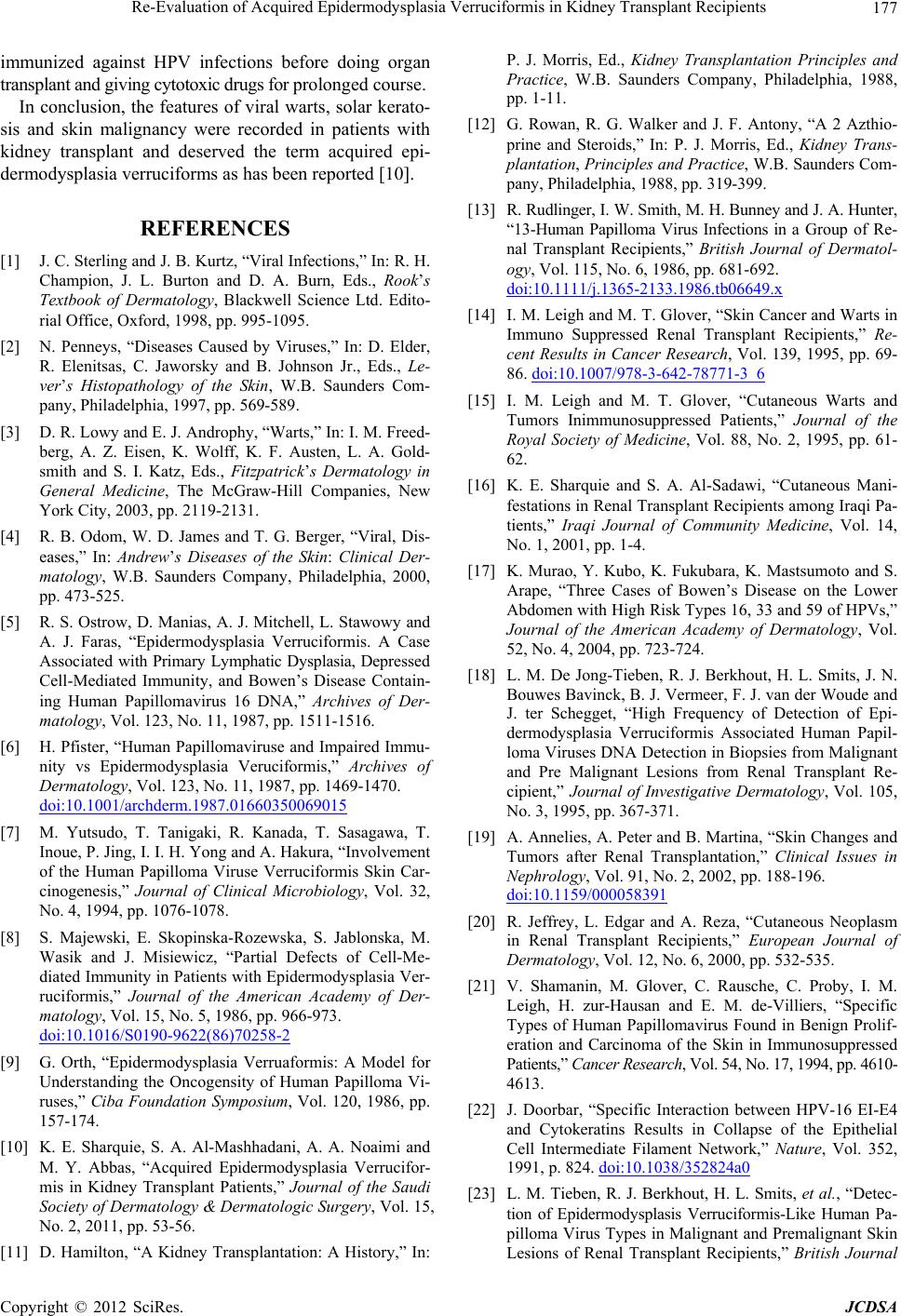
Re-Evaluation of Acquired Epidermodysplasia Verruciformis in Kidney Transplant Recipients 177
immunized against HPV infections before doing organ
transplant and giving cytotoxic drugs for prolonged course.
In conclusion, the features of viral warts, solar kerato-
sis and skin malignancy were recorded in patients with
kidney transplant and deserved the term acquired epi-
dermodysplasia verruciforms as has been reported [10].
REFERENCES
[1] J. C. Sterling and J. B. Kurtz, “Viral Infections,” In: R. H.
Champion, J. L. Burton and D. A. Burn, Eds., Rook’s
Textbook of Dermatology, Blackwell Science Ltd. Edito-
rial Office, Oxford, 1998, pp. 995-1095.
[2] N. Penneys, “Diseases Caused by Viruses,” In: D. Elder,
R. Elenitsas, C. Jaworsky and B. Johnson Jr., Eds., Le-
ver’s Histopathology of the Skin, W.B. Saunders Com-
pany, Philadelphia, 1997, pp. 569-589.
[3] D. R. Lowy and E. J. Androphy, “Warts,” In: I. M. Freed-
berg, A. Z. Eisen, K. Wolff, K. F. Austen, L. A. Gold-
smith and S. I. Katz, Eds., Fitzpatrick’s Dermatology in
General Medicine, The McGraw-Hill Companies, New
York City, 2003, pp. 2119-2131.
[4] R. B. Odom, W. D. James and T. G. Berger, “Viral, Dis-
eases,” In: Andrew’s Diseases of the Skin: Clinical Der-
matology, W.B. Saunders Company, Philadelphia, 2000,
pp. 473-525.
[5] R. S. Ostrow, D. Manias, A. J. Mitchell, L. Stawowy and
A. J. Faras, “Epidermodysplasia Verruciformis. A Case
Associated with Primary Lymphatic Dysplasia, Depressed
Cell-Mediated Immunity, and Bowen’s Disease Contain-
ing Human Papillomavirus 16 DNA,” Archives of Der-
matology, Vol. 123, No. 11, 1987, pp. 1511-1516.
[6] H. Pfister, “Human Papillomaviruse and Impaired Immu-
nity vs Epidermodysplasia Veruciformis,” Archives of
Dermatology, Vol. 123, No. 11, 1987, pp. 1469-1470.
doi:10.1001/archderm.1987.01660350069015
[7] M. Yutsudo, T. Tanigaki, R. Kanada, T. Sasagawa, T.
Inoue, P. Jing, I. I. H. Yong and A. Hakura, “Involvement
of the Human Papilloma Viruse Verruciformis Skin Car-
cinogenesis,” Journal of Clinical Microbiology, Vol. 32,
No. 4, 1994, pp. 1076-1078.
[8] S. Majewski, E. Skopinska-Rozewska, S. Jablonska, M.
Wasik and J. Misiewicz, “Partial Defects of Cell-Me-
diated Immunity in Patients with Epidermodysplasia Ver-
ruciformis,” Journal of the American Academy of Der-
matology, Vol. 15, No. 5, 1986, pp. 966-973.
doi:10.1016/S0190-9622(86)70258-2
[9] G. Orth, “Epidermodysplasia Verruaformis: A Model for
Understanding the Oncogensity of Human Papilloma Vi-
ruses,” Ciba Foundation Symposium, Vol. 120, 1986, pp.
157-174.
[10] K. E. Sharquie, S. A. Al-Mashhadani, A. A. Noaimi and
M. Y. Abbas, “Acquired Epidermodysplasia Verrucifor-
mis in Kidney Transplant Patients,” Journal of the Saudi
Society of Dermatology & Dermatologic Surgery, Vol. 15,
No. 2, 2011, pp. 53-56.
[11] D. Hamilton, “A Kidney Transplantation: A History,” In:
P. J. Morris, Ed., Kidney Transplantation Principles and
Practice, W.B. Saunders Company, Philadelphia, 1988,
pp. 1-11.
[12] G. Rowan, R. G. Walker and J. F. Antony, “A 2 Azthio-
prine and Steroids,” In: P. J. Morris, Ed., Kidney Trans-
plantation, Principles and Practice, W.B. Saunders Com-
pany, Philadelphia, 1988, pp. 319-399.
[13] R. Rudlinger, I. W. Smith, M. H. Bunney and J. A. Hunter,
“13-Human Papilloma Virus Infections in a Group of Re-
nal Transplant Recipients,” British Journal of Dermatol-
ogy, Vol. 115, No. 6, 1986, pp. 681-692.
doi:10.1111/j.1365-2133.1986.tb06649.x
[14] I. M. Leigh and M. T. Glover, “Skin Cancer and Warts in
Immuno Suppressed Renal Transplant Recipients,” Re-
cent Results in Cancer Research, Vol. 139, 1995, pp. 69-
86. doi:10.1007/978-3-642-78771-3_6
[15] I. M. Leigh and M. T. Glover, “Cutaneous Warts and
Tumors Inimmunosuppressed Patients,” Journal of the
Royal Society of Medicine, Vol. 88, No. 2, 1995, pp. 61-
62.
[16] K. E. Sharquie and S. A. Al-Sadawi, “Cutaneous Mani-
festations in Renal Transplant Recipients among Iraqi Pa-
tients,” Iraqi Journal of Community Medicine, Vol. 14,
No. 1, 2001, pp. 1-4.
[17] K. Murao, Y. Kubo, K. Fukubara, K. Mastsumoto and S.
Arape, “Three Cases of Bowen’s Disease on the Lower
Abdomen with High Risk Types 16, 33 and 59 of HPVs,”
Journal of the American Academy of Dermatology, Vol.
52, No. 4, 2004, pp. 723-724.
[18] L. M. De Jong-Tieben, R. J. Berkhout, H. L. Smits, J. N.
Bouwes Bavinck, B. J. Vermeer, F. J. van der Woude and
J. ter Schegget, “High Frequency of Detection of Epi-
dermodysplasia Verruciformis Associated Human Papil-
loma Viruses DNA Detection in Biopsies from Malignant
and Pre Malignant Lesions from Renal Transplant Re-
cipient,” Journal of Investigative Dermatology, Vol. 105,
No. 3, 1995, pp. 367-371.
[19] A. Annelies, A. Peter and B. Martina, “Skin Changes and
Tumors after Renal Transplantation,” Clinical Issues in
Nephrology, Vol. 91, No. 2, 2002, pp. 188-196.
doi:10.1159/000058391
[20] R. Jeffrey, L. Edgar and A. Reza, “Cutaneous Neoplasm
in Renal Transplant Recipients,” European Journal of
Dermatology, Vol. 12, No. 6, 2000, pp. 532-535.
[21] V. Shamanin, M. Glover, C. Rausche, C. Proby, I. M.
Leigh, H. zur-Hausan and E. M. de-Villiers, “Specific
Types of Human Papillomavirus Found in Benign Prolif-
eration and Carcinoma of the Skin in Immunosuppressed
Patients,” Cancer Research, Vol. 54, No. 17, 1994, pp. 4610-
4613.
[22] J. Doorbar, “Specific Interaction between HPV-16 EI-E4
and Cytokeratins Results in Collapse of the Epithelial
Cell Intermediate Filament Network,” Nature, Vol. 352,
1991, p. 824. doi:10.1038/352824a0
[23] L. M. Tieben, R. J. Berkhout, H. L. Smits, et al., “Detec-
tion of Epidermodysplasis Verruciformis-Like Human Pa-
pilloma Virus Types in Malignant and Premalignant Skin
Lesions of Renal Transplant Recipients,” British Journal
Copyright © 2012 SciRes. JCDSA